The long-awaited second installment of the article about Tolkien’s special hidden realms has arrived! In Part One, which you can read here, C.E High explored the hidden realms of the First Age. In Part Two, he continues on to consider hidden realms of the Second and Third Ages. Enjoy!
In the second and third ages the devices that Tolkien uses with his realms blossom into more complex symbolism with a diversity of outcomes. As men grow and diversify, this creates new problems for the other races of Middle-earth leading to a variety of realms that grow out of need and out of want. There is also that pesky Sauron, Morgoth’s second in command in the elder days, and in the absence of his master he arguably surpasses him in malice and evil deeds in the land of Mordor.
No longer do we have three hidden elven kingdoms of a similar making, we now have a variety. Eregion and Lothlorien are, at first, settlements of the displaced Noldor, which quickly become refuges against the evil now located in the east of Middle-earth. Rivendell, and the Woodland Realm to the north of Eregion and Lothlorien, round out the retreats of elves from battles with Sauron. Last, but not least, we have the newest and most intriguing hidden realm of them all: The Shire, a realm founded in the third age.
When the war of the ring breaks out at the end of the third age, one senses that its symbolism and “hiddeness” were a must for Tolkien in his stories. He was always the most particular about the Shire and its inhabitants, describing Hobbits in more detail than many of his other creations” “I picture a fairly human figure, not a kind of ‘fairy’ rabbit as some of my British reviewers seem to fancy: fattish in the stomach, shortish in the leg. A round, jovial face; ears only slightly pointed and ‘elvish’; hair short and curling (brown). The feet from the ankles down, covered with brown hairy fur. Clothing: green velvet breeches; red or yellow waistcoat; brown or green jacket; gold (or brass) buttons; a dark green hood and cloak (belonging to a dwarf).” – Humphry Carpenter with assistance from Christopher Tolkien, The Letters of J.R.R. Tolkien, Letter 27. The Shire is the most interesting realm to interpret; we’ll get to that later though.
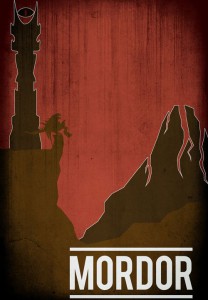
Throughout of the second and third ages of the world, there is a dark power brooding in the shadow lands with the sole purpose of its master to dominate all life on Middle-earth. Just like its father realm of Angband from before, Mordor is a dark and desolate place that Tolkien describes to us in this manner: “Mordor was unique because of the three enormous mountain ranges surrounding it, from the north, from the west and from the south. The mountains both protected the land from an unexpected invasion by any of the people living in those directions and kept those living in Mordor from escaping” – Clyde Kilby, Many Meetings with Tolkien. This realm like the one before it was the enemy of the free peoples of Middle-earth and, like the one before it, was shrouded in shadow and flame. However it was not shrouded from the eyes of everyone who lived during this time. Just like Angband before it, everybody knew where Mordor was and everyone feared to go into it.
As I stated before, I believe that Tolkien uses Angband to symbolize Morgoth’s jealousy with the world and creation, his fortress is his physical manifestation of his need to dominate all in Middle-earth. What then do we make of Mordor? What is Tolkien trying to tell us about evil this second time around and the new dark lord? Sauron chooses Mordor for a reason, for its geographic barriers. If you look at Mordor on a map you will notice that the mountain ranges surround it on three sides. It’s no coincidence that the three sides are defended by the Ash Mountain ranges and they are facing, like the quote says above, the very peoples that Sauron was to make war upon.
With this information in hand, one can deduce that Mordor symbolizes evil on the defensive and therefore deception is what is needed by its master, which is why Sauron takes on the persona of the gift giver. Tolkien is showing us that the tables have turned on shadow this time around, even though Sauron uses similar tactics as his mentor of sending out his servants to terrorize the world, the game has changed, evil is hampered after the War of Wrath. Many strong Elves remain in Middle-earth after the first age and the Men of Numenor are constantly sailing to Middle-earth to exert their presence there.
Mordor symbolizes the defensive embodiment of evil and deception in the second age, as the realm itself is a shrouded cloud “Mists curled and smoked from dark and noisome pools. The reek of them hung stifling in the still air. Far away, now almost due south, the mountain-walls of Mordor loomed, like a black bar of rugged clouds floating above a dangerous fog-bound sea” J.R.R. Tolkien, The Two Towers. By the third age evil is really on the defensive, as Sauron, no longer able to take physical form is bound to the realm itself, much like his former master was bound to his realm after extending his life force into his creations.
If Mordor is the embodiment of evil and the defensive in the later ages of Middle-earth, it is because for a while the light realms do have the upper hand for some time and what we see is a diversification of them. As the new realm of darkness is more complex and gets more characterization, the realms of good get more diverse as well. One of the most important of these places is the land of Eregion, founded by the remaining Noldor who stay behind at the end of the first age.

Nestled at the foot of the Misty Mountains and the western side, Eregion sees a friendship renewed and improved upon between the elves who live there and the dwarves of Kazad-dum. Eregion is hidden both by the mountains they are nestled in and also the by the power and creativity of the Noldor. “Those Elves who had survived the vicissitudes of the First Age begin a new kingdom in Eregion, and during the Second Age, the Elves of Eregion forge many magical rings, including 19 Rings of Power with the aid of Sauron. At this time Sauron is still able to put on a fair appearance and manages to fool the elves into believing his intentions are good. But he deceived them, for in secret he had made the One Ring for himself in order to enslave them and all the other peoples of Middle-earth.” Christopher Tolkien, The Silmarillion.
Eregion, I would argue, is the most complex and wrought-with-meaning realm in all of Tolkien’s writing. It represents the ingenuity of the elves, with their magical powers stemming from the light, Eregion is known throughout its existence as the realm where many magical objects are crafted and is seen as the most powerful elven realm east of the sea. It represents the righteousness of two races in Middle-earth living in harmony, with peace and friendship between Eregion and Kazad-dum, as it is also the most prosperous realm through its trade with the dwarves. But, it also represents the gullibility of the forces of light as the elves of Eregion are easily tricked by Sauron into forging the rings of power, which of course brings about its downfall. Tolkien is showing us how much good can achieve in a short time when setting goals and working together as fellows, but he’s also quick to point out such strong focus and false sense of security can bring about bad ends. Much like a giant star in space that burns for only a short period of time and then explodes to create a nebulous of new smaller stars, Eregion’s bright life is short lived. It burns out in the form of its downfall at the hands of Sauron’s orcs, but out of its ashes we see the rise of Rivendell and the strengthening of Lothlorien.
As with the founding of Eregion at the beginning of the second age being a new home and refuge for the remaining Noldor, the Woodland Realm established around the same time in the great forest of Rhovanion was a refuge for those Sindar who stayed in Middle-earth after the first age. As the tale tells the Woodland Realm is made up mostly of Silvan elves but is ruled by the remnants of the inhabitants of Doriath looking for a home similar to the one that they left behind. “In the early part of the Second Age, the Woodland Realm was established in Greenwood the Great by a lord of the Sindarin Elves who had migrated eastward from Lindon. The Woodland Realm was a mingling of two types of elves, Sindar coming from the ruin of Doriath, and the Silvan or Wood elves who had already been settled there. Oropher, who had chosen not to depart Middle-earth after the destruction of Beleriand, chose to settle in Greenwood the Great and was taken by the Silvan Elves as their Lord” Christopher Tolkien, Unfinished Tales of Numenor and Middle-earth.
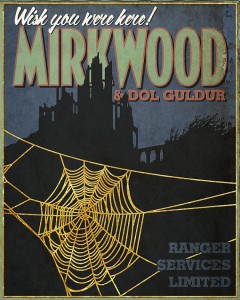
Seeking to find the author’s meaning for the Woodland Realm we need only to look for the circumstances of its founding and subsequent move north a thousand years later. The realm of the great greenwood is founded by the refugees of Doriath and thus made to resemble their lost home in many ways. Much like Doriath the realm is situated in the heart of a dense forest. Also like Doriath where King Thingol, a grey elf who had began the journey west, ruled over a mixture of Sindar, Silvan or green elves, and dark elves, those who had not attempted the journey; in the Woodland Realm King Oropher and later his son King Thanduil were Sindar who ruled over a mixture of their kind and green or wood elves as they were later called. And like Menegroth the Woodland Realm is delved deep into the caverns of the forest in which it is situated.
The caverns are delved not to the degree and splendor of Menegroth or Nargothrond but are done so for the same reason, protection from a dark power, this time the growing threat from Sauron which will eventually transform the great greenwood into Mirkwood. All of this points to one thing, nostalgia, the Woodland Realm is the realm of nostalgia in Middle-earth and is the second realm spawned from Doriath. However unlike Nargothrond which was a copy of an existing realm at the time the realm of the Wood elves is one of remembrance, a longing for what was lost and a tribute however unintentional or degree of need to a home that the leaders at least once knew.
From the downfall of Eregion, two more hidden realms came into Tolkien’s writing, one was founded by Elrond to the north in the valley of Imladris we’ll get to that one in a minute. The second was already in existence before Eregion’s downfall. Lothlorien was around possibly as early as the first age but it didn’t factor into Tolkien’s legendarim until Galadril and her husband Celeborn migrated there, possibly mid way through the second age. They brought with them a gift given to them by Gil-galad, given to him by the seventh High King of Numenor, Tar-Aldarion: seeds of the great Mallorn trees whose boughs were filled with leaves of gold and whose wood was silver. He gave them to Galadriel and Celeborn because the trees wouldn’t grow in his own land.“That is the fairest of all the dwellings of my people. There are no trees like the trees of that land. For in the autumn their leaves fall not, but turn to gold. Not till the spring and the new green opens do they fall, and then the boughs are laden with yellow flowers; and the floor of the wood is golden, and golden is the roof, and its pillars are of silver, for the bark of the trees is smooth and grey” J.R.R. Tolkien, The Fellowship of the Ring.
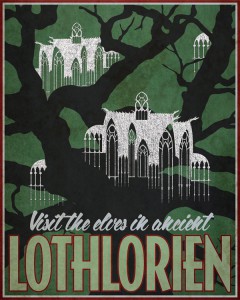
Through Galadrial’s power as a high member of the Noldor, and her wielding of one of the three elven magic rings, she is able to recreate the undying lands of which she inhabited long ago. Therefore the realm of Lothlorien is the preservation of light and good, and the suspension of time and space. It is the complete recreation of Valinor in Middle-earth. Its geography is also important; Tolkien chose to put the preservation of the west the closest of all the hidden realms to Mordor, the sworn enemy of the west being shrouded, much like Doriath before it (in which Galadril spent many years) in a girdle of magical protection. Lothlorien is the closest that anyone in Middle-earth could ever get to experiencing the undying lands without making the great journey across the sea. If the Woodland realm is nostalgia for what was lost and Eregion was good’s ability to create, then Lothlorien is good’s ability to recreate what was lost.
Perhaps the most famous of all the hidden realms of the elves in Middle-earth, even to the casual Tolkien fan, is the one located in the valley of Imladris tucked away at the north western foot of the Misty Mountains. This realm, commonly referred to as Rivendell, is a favorite of director Peter Jackson, as he devoted a good amount of time and energy into the portrayal of Rivendell in both The Lord of the Rings and The Hobbit trilogies. Rivendell is a cozy yet awe inspiring place, as the elf Elrond uses one of the three elven magic rings to create what Gandalf refers to as “the last homely house east of the sea.” Rivendell is very much hidden from all eyes except for the ones in which Elrond allows to see, much like all of the other hidden realms discussed here Men, Dwarves, and Hobbits must be invited and shown the way into Rivendell. “In all the days of the Third Age, after the fall of Gil-galad, Master Elrond abode in Imladris, and he gathered there many Elves, and other folk of wisdom and power from among all the kindreds of Middle-earth, and he preserved through many lives of Men the memory of all that had been fair; and the house of Elrond was a refuge for the weary and the oppressed, and a treasury of good counsel and wise lore” Christopher Tolkien, The Silmarillion.
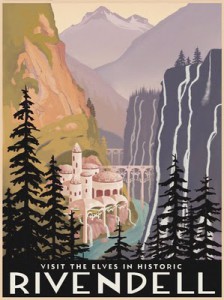
I believe the hidden outpost at Imladris shares much the same purpose as its sibling realm of Lothlorien to the east, however with one caveat: as one reads through the pages on Rivendell and gets a feel for what takes place there in the stories, the meaning that jumps out to me is preservation of knowledge and learning. The characters of Middle-earth always come to Rivendell, not just as a refuge from evil but also for education that they cannot find anywhere else. Thorin Oakenshield comes to Rivendell for an interpretation of a map that cannot be read anywhere else, Bilbo Baggins comes to be inspired and write his stories and poetry in his later years, and Gandalf is constantly coming to seek Elronds council on many matters. The council of the ring is held there, where all of the races of Middle-earth decide what to do with it and King Elessar is fostered there, who will later become arguable the most learned king of men ever. If Lothlorien is the creation of the physical west, then Rivendell is the creation of the knowledge of the west in Middle-earth.
We saved the best for last! The last of the hidden realms of Middle-earth is not hidden by intention, nor is it hidden because of its vast importance for the forces of good and light. At least that is what Tolkien wants you to see on the surface. The Shire is a paradox; it is the most important of the realms to the author and to the story of The Lord of the Rings while the reader is told over and over again of its insignificance in the wide world.
The whole story of The Hobbit is based on the fact that Bilbo wants to leave the boring old Shire to seek adventure out his doorstep, insignificance. However in The Lord of the Rings, Frodo decides to be the ring bearer first in order to save The Shire from evil; it’s only later that he makes the decision to keep going for all of Middle-earth but without his love for The Shire, he would have never set out in the first place, most important. The Shire was the most significant realm to Tolkien as he went into great detail of the place that he modeled on the land of his youth, the English countryside. “I feel that as long as the Shire lies behind, safe and comfortable, I shall find wandering more bearable: I shall know that somewhere there is a firm foothold, even if my feet cannot stand there again.” J.R.R. Tolkien, The Fellowship of the Ring.
In his formative years Tolkien spent much of his time in this landscape and his love affair with it never diminished. The Hobbits are modeled on the people that Tolkien grew up with same as the landscape is modeled on the environment Tolkien always loved. “The Hobbits named it the Shire, as the region of the authority of their Thain, and a district of well-ordered business; and there in that pleasant corner of the world they plied their well-ordered business of living, and they heeded less and less the world outside where dark things moved, until they came to think that peace and plenty were the rule in Middle-earth and the right of all sensible folk. They forgot or ignored what little they had ever known of the Guardians, and of the labours of those that made possible the long peace of the Shire. They were, in fact, sheltered, but they had ceased to remember it” J.R.R. Tolkien, The Lord of the Rings.
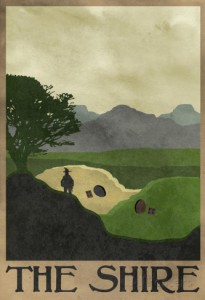
What is so interesting about The Shire is that its “hiddeness” is not from without as a purposeful attempt to keep the darkness at bay like all the others, but from within. The hobbits become so introverted over the course of their years in the Shire that they simply shut the rest of the world out. They are also so insignificant to the geopolitics of Middle-earth that most outside of it have never heard of the Shire or hobbits, hence the unintentional and introverted “hiddeness.”
The Shire, much more so than any of the other realms is very personal for Tolkien, he tries to keep his story there as long as he possible can (In the Lord of the Rings the characters don’t leave the Shire for the first hundred pages or so). Also, the Shire serves as a spring board for the beginning and a landing place for the end of both The Hobbit and The Lord of the Rings tales, attesting to Tolkien’s own love for it and sense of safety he felt it brought him. In the end The Shire is the ultimate realm of safety and comfort for the reader and the author himself. Tolkien is telling us that when you have the rural comfy setting, the world will pass you by and you will be forgotten before you know it, as the hobbits of the Shire were after years of complacency.
You’re might be thinking where is the love for the Dwarves? They had realms too, some of them could even be classified in the hidden category. I agree the dwarves are an integral part of Tolkien’s world and much of their actions and places drive the narrative at times. I am working on a separate article focusing not on the hidden aspects of dwarvish homes but the commonalities of the different realms of the people of Durin and their interactions with others in Middle-earth, some of which I have hinted at here in these pages.
In the end, each of the hidden realms of Middle-earth held a distinct and meaningful symbolism for Tolkien and I think it is in these meanings that we can see the reason for which these numerous realms existed and their functions in his fiction. Is this setup of evil out in the open and good hidden from sight applicable to our own world and times? I would say yes, and I would say one need to only look at the media coverage and what gets the most publicity in today’s world. Humans tend to always gravitate to the evil in this world and put it out there for others to see more than the acts of kindness and love.
Is evil more prevalent than good in this world? I don’t think so, just as there were more good realms in Middle-earth than evil ones I believe there is more kindness than ugliness, but I do think that evil is more entertaining and therefore litters the public sphere more than it should. Just as Angband and Mordor sought to dominate the landscape of Middle-earth and Gondolin and Rivendell sought to repel them, evil will always be the catalyst and agitator, with love there to restore order.
– C.E. High is a European history teacher and Tolkien Scholar living and working in Texas.


